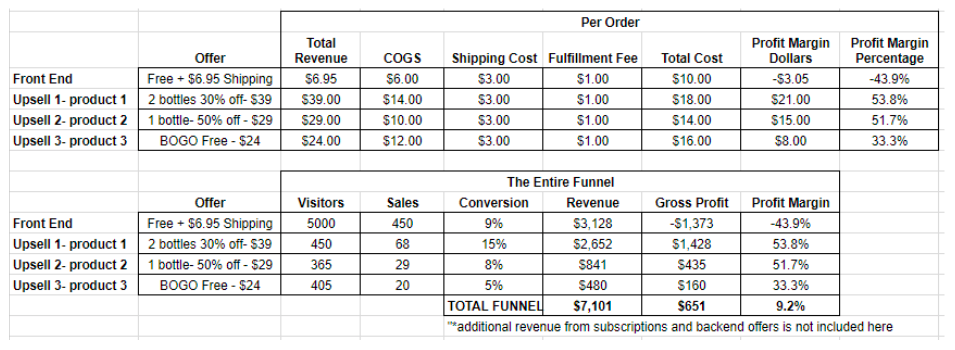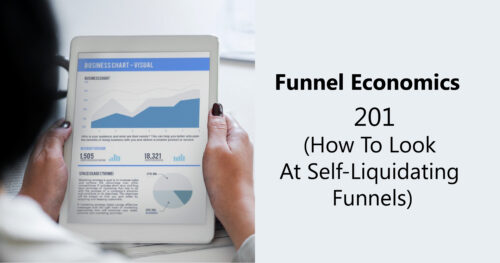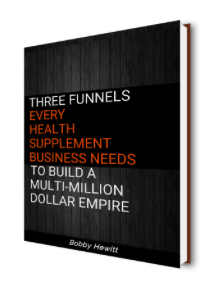Building a direct response, self-liquidating funnel seems easy from the outside. Offer a low priced product on the initial sale then make up the loss of revenue with upsells and your back-end offers over time.
In fact, many direct response marketers don’t give it a second thought. They simply add products in the funnel upsell flow that they have on hand.
The marketers that do take the time to think, all approach it the same way. They ask what fits as the next step to meet the buyers needs.
That approach is a great place to start. But when you’re looking to optimize a funnel for maximize profit, it pays to go deeper.
The Art And Science Of Self-Liquidating Funnels
Looking at a funnel from a different perspective, reveals all of it’s inner levers. And when you pull on one lever it always affects another lever.
Modeling out the economics of a new funnel, or an existing funnel, is a great way to understand the profit potential and improve upon it.
Creative Thirst has developed a way to evaluate a specific funnel configuration against another. (In fact, it’s part of our economic framework that we take all of our clients through.)
Only through economic comparison can we see how one self-liquidating funnel configuration may be better or worse than another.
And it works, even if you only have a few products to use as upsells, because there are infinite ways you can offer your products.
In essence, we model out different funnel configurations to find the flaws (stress testing it) before putting it into the marketplace.
This approach enables us to optimize self-liquidating funnels for maximum return to our dietary supplement clients.
We call it, Funnel Economics…
An In-Depth Look At Funnel Economics
Simply put, the economics of your funnel will tell you how profitable that funnel is.
Normally marketers only calculate how much total revenue a funnel has made.
To compare funnels and different traffic sources, marketers look at Revenue Per Visitor (RPV) to evaluate a funnel.
Revenue Per Visitor = (Total funnel revenue) / (Total visitors that came in at the top of the funnel)
Revenue per visitor is a quick way of comparing the performance of one funnel over another, or over time.
But there is a fundamental mistake in only looking at the revenue a funnel generates.
Just looking at the total revenue hides many flaws.
For one, the profitability of a funnel is hidden when you only look at revenue because you’re not accounting for Cost Of Goods Sold (COGS).
A Better Way To Look At Funnel Economics
The better way of evaluating a funnel is to look at the Net Revenue of each offer and each funnel.
This tells you how much money your funnel actually made. Net revenue is the total amount of the money you made from sales minus your direct expenses.
Knowing your net revenue will help you understand what offers in your funnel are working and by comparison which ones can work better. Then you can make adjustments to your offers to maximize your net.
Net Revenue Dollars are calculated by taking the revenue (or gross sales) made for each offer in a funnel and subtracting out the COGS, shipping costs and fulfillment fees, and any other costs associated with the individual products.
Here’s an example:
First you’ll need to figure out the Profit Margin of each offer in your funnel.
So for each product in your funnel or one that you’re thinking of adding, you’ll need to first calculate the Profit Margin Dollars.
Profit Margin Dollars =
(Price + Shipping paid by the customer) – (COGS + Shipping + Fulfillment Fee)
Then calculate the margin percentage:
Profit Margin Percentage =
(Margin Dollars Per Offer) / (Price Per Offer)
Profit Margin Dollars tells you how much money your funnel is making after all costs.
Profit Margin Percentage tells you how big, a slice of the pie that your funnel is allowing you to keep.
Looking at Profit Margin two different ways, in dollars and as a percentage, gives you an overall view of the impact per product.

Then you need to look at the impact of each item in the funnel by calculating the Profit Dollars and Percentage for the Entire Funnel based on actual or anticipated traffic, conversion and sales.
Ordering Your Upsells For Maximum Profit
As mentioned earlier, many marketers either add products in the funnel upsell flow that they have on hand. They more or less pick them off the shelf and plug them in.
Or they stop to ask, “What would the buyer need next?”, and then offer that as the next upsell.
In both cases never stopping to evaluate how the sales margins look or their impact on revenue.
If the margin percentage of your upsell offers does not go from high to low in your funnel, as in the previous example, then you might be losing money.
In this chart I simply reversed the order of the upsells, assuming the same conversion rate for each step in the funnel.

Ordering upsells by highest net revenue margin ensures you’ll capture the most margin before people and conversions diminish.
The deeper your funnel (the more upsell stages) the more people will drop off. It’s just the nature of funnels. So, if you’re not net positive until your 2nd or third upsell you have very little chance of making much money.
Also if the top of your funnel has several negative net revenue percentage offers, like soft offers that just collect shipping up front. This might be a sign of a weak funnel, sacrificing profits for conversion.
Typically such a funnel only gets to positive percentages deeper in, once the customers buy more through subscriptions or future backend offers.
However, you may want to deliberately break these rules if your offers just make more sense in a particular order, regardless of profit margins. Funnels are as much an art as they are a science.
The art of a funnel can sometimes take precedence over the economics. For example, if one offer makes perfect sense as your 2nd upsell but the margin percentage is not as good as the 3rd upsell this does not mean you should switch the order of these.
Start With Funnel Economics
New customers flow into your business through funnels, ascend to higher value customers on the backend, and are the lifeblood to making a direct response dietary supplement business work.
Spending more time examining funnels through the funnel economics is critical to success. Yet sadly many marketers don’t take the time to model out a funnel.
Even if you’ve been building funnels for years, it pays to break it down systematically, because basic funnel economics uncovers flaws you can’t see by only looking at conversion rates.
Discover the 3 funnels that can help your health supplement business succeed.

Listen to the Health Supplement Business Mastery Podcast for for dietary supplement entrepreneurs and marketers.




